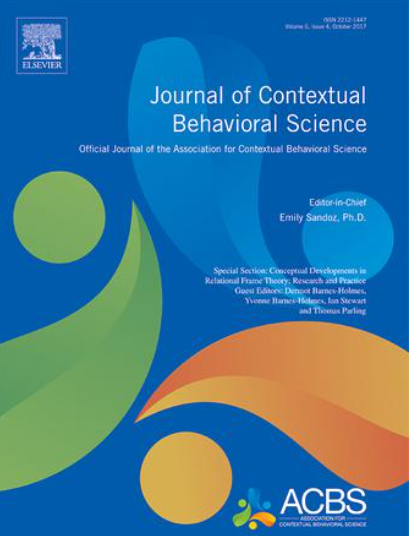针对儿童广泛性焦虑的重复消极思维与非指导性治疗的ACT的具体比较
IF 3
3区 心理学
Q1 PSYCHOLOGY, CLINICAL
引用次数: 0
摘要
焦虑症在儿童中很常见,其中最普遍的是广泛性焦虑症(GAD)。认知行为疗法(CBT)已经证明了治疗这些疾病的有效性,但仍有改进的余地。值得注意的是,最广泛测试的CBT干预只比非指导性治疗(NDT)稍微有效一点,后者通常被用作心理安慰剂干预。接受与承诺疗法(ACT)是CBT的一种替代疗法,作为儿童焦虑症的一种可行的治疗方法正获得越来越多的关注。具体来说,ACT的一个版本更深入地整合了关系框架理论(RFT),并针对重复性消极思维(RNT),似乎特别适合于解决儿童的广泛性焦虑症。本研究对以rnt为重点的ACT与NDT治疗8-12岁儿童广泛性焦虑症进行了具体比较。该研究采用随机、双样本、多基线设计,共有17名参与者。干预措施通过视频会议进行,包括三次45分钟的会议。结果表明,接受以rnt为重点的ACT方案的参与者在情绪症状和病理性担忧方面比接受NDT的参与者表现出更大的改善,正如父母和孩子所报告的那样。根据他们父母的报告,焦虑的减少介导了所有参与者以rnt为重点的ACT干预的效果。总之,以rnt为重点的简短ACT干预措施有望治疗儿童广泛性焦虑症。本文章由计算机程序翻译,如有差异,请以英文原文为准。
An idiographic comparison of ACT focused on repetitive negative thinking versus non-directive therapy in child generalized anxiety
Anxiety disorders are common among children, with generalized anxiety disorder (GAD) being one of the most prevalent. Cognitive-behavioral therapy (CBT) has demonstrated efficacy in treating these disorders, but there is still room for improvement. Notably, the most extensively tested CBT intervention is only slightly more efficacious than non-directive therapy (NDT), which is often used as a psychological placebo intervention. Acceptance and commitment therapy (ACT) is an alternative to CBT and is gaining traction as a viable treatment for childhood anxiety disorders. Specifically, a version of ACT that integrates relational frame theory (RFT) in greater depth and targets repetitive negative thinking (RNT) appears particularly suited for addressing GAD in children. This study conducted an idiographic comparison of RNT-focused ACT versus NDT for treating GAD in children aged 8–12 years. The research employed a randomized, two-sample, multiple-baseline design with 17 participants. The interventions were delivered via videoconference and consisted of three 45-min sessions. The results indicated that participants who received the RNT-focused ACT protocol demonstrated greater improvements in emotional symptoms and pathological worry than those who received NDT, as reported by parents and children. The reduction of worry mediated the effect of the RNT-focused ACT intervention for all participants, according to their parents’ reports. In conclusion, brief RNT-focused ACT interventions are promising for treating GAD in children.
求助全文
通过发布文献求助,成功后即可免费获取论文全文。
去求助
来源期刊

Journal of Contextual Behavioral Science
PSYCHOLOGY, CLINICAL-
CiteScore
8.50
自引率
18.00%
发文量
82
审稿时长
61 days
期刊介绍:
The Journal of Contextual Behavioral Science is the official journal of the Association for Contextual Behavioral Science (ACBS).
Contextual Behavioral Science is a systematic and pragmatic approach to the understanding of behavior, the solution of human problems, and the promotion of human growth and development. Contextual Behavioral Science uses functional principles and theories to analyze and modify action embedded in its historical and situational context. The goal is to predict and influence behavior, with precision, scope, and depth, across all behavioral domains and all levels of analysis, so as to help create a behavioral science that is more adequate to the challenge of the human condition.
 求助内容:
求助内容: 应助结果提醒方式:
应助结果提醒方式:


